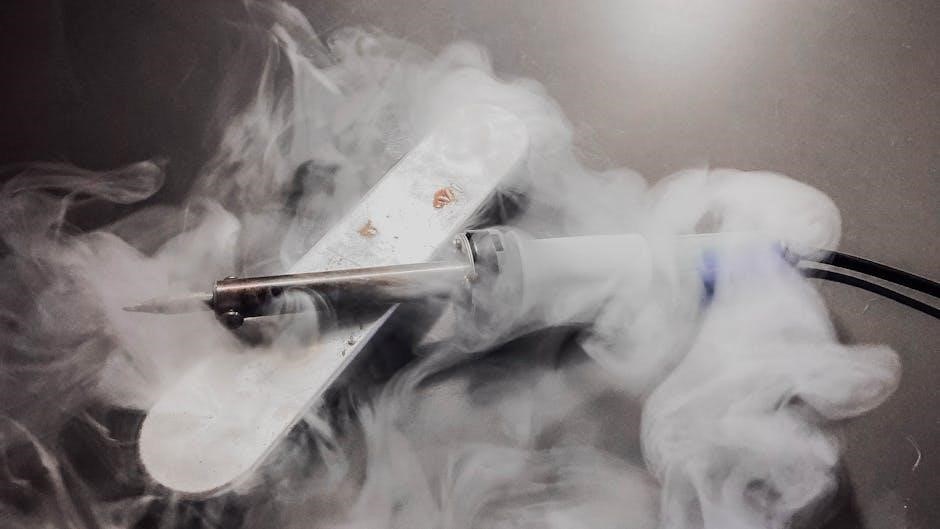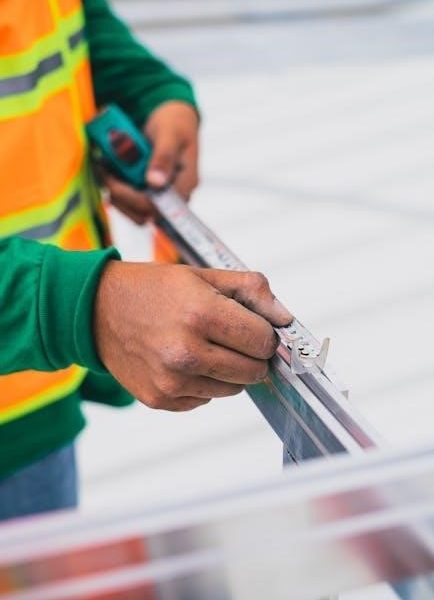This manual contains important information about smoke alarm operation and installation procedures using
- step by step guides
for proper usage and safety precautions to ensure effective smoke detection and alarm systems function correctly always․
Purpose of the Manual
The purpose of this manual is to provide users with essential information about the smoke detector, its operation, and installation․ The manual aims to educate users on the proper use and maintenance of the smoke detector to ensure it functions correctly and provides early warning in case of a fire․ By following the guidelines outlined in this manual, users can maximize the effectiveness of their smoke detector and minimize the risk of false alarms․ The manual is intended for use by individuals who are installing, operating, or maintaining smoke detectors, and it provides a comprehensive overview of the device’s features and capabilities․ The information contained in this manual is based on the latest research and industry standards, and it is designed to be easy to understand and follow․ Overall, the purpose of this manual is to help users get the most out of their smoke detector and stay safe in the event of a fire․ The manual is an important resource for anyone who wants to ensure their smoke detector is working properly and providing reliable protection․
Regulatory Conformance
This smoke detector manual conforms to all relevant regulatory requirements, ensuring that the device meets the necessary standards for safety and performance․ The manual complies with industry regulations, including those related to fire safety and electronic devices․ By adhering to these regulations, the smoke detector is guaranteed to provide reliable and effective protection against fires․ The regulatory conformance of this manual is verified through rigorous testing and certification processes, which validate the device’s ability to detect smoke and alert users in a timely manner․ The manual’s regulatory conformance is also subject to periodic review and update, ensuring that it remains aligned with the latest industry standards and regulations․ This commitment to regulatory conformance provides users with confidence in the smoke detector’s ability to perform as intended, and it helps to minimize the risk of non-compliance with relevant laws and regulations․ The manual’s regulatory conformance is an essential aspect of its overall quality and effectiveness․

Understanding Smoke Detectors
Smoke detectors are electronic devices using
- sensors
to detect smoke particles and alert users of potential fires quickly and effectively always․
Types of Smoke Detectors
There are several types of smoke detectors available, including photoelectric and ionization smoke detectors, which use different methods to detect smoke particles․ Photoelectric smoke detectors use a light source to detect smoke, while ionization smoke detectors use a small amount of radioactive material to detect smoke․ Additionally, there are combination smoke detectors that combine both photoelectric and ionization technologies․ Some smoke detectors are also equipped with additional features such as carbon monoxide detection and wireless connectivity․ These different types of smoke detectors are designed to provide effective smoke detection in various environments and situations․ The choice of smoke detector type depends on the specific needs and requirements of the user․ It is essential to select a smoke detector that meets the necessary safety standards and regulations․ By understanding the different types of smoke detectors, users can make informed decisions when selecting a smoke detector for their homes or businesses․ Using the correct type of smoke detector can help ensure effective smoke detection and alert users of potential fires․
Functionality of Smoke Detectors
Smoke detectors are designed to detect smoke particles in the air and alert users of potential fires․ The functionality of smoke detectors is based on the principle of detecting smoke particles and triggering an alarm․ Smoke detectors typically consist of a sensor, a circuit board, and a sounder․ The sensor detects smoke particles and sends a signal to the circuit board, which then triggers the sounder to produce a loud alarm; Some smoke detectors also have additional features such as flashing lights or vibration to alert users who may be deaf or hard of hearing․ The functionality of smoke detectors can be affected by various factors such as dust, humidity, and temperature․ Regular maintenance and testing are essential to ensure that smoke detectors are functioning correctly․ By understanding how smoke detectors work, users can appreciate the importance of proper installation, maintenance, and testing to ensure effective smoke detection․ Overall, the functionality of smoke detectors is critical to providing early warning of potential fires!

Installation of Smoke Detectors
Proper installation is crucial for smoke detectors to function correctly using specialized tools and following manufacturer guidelines always․
Location and Installation

To ensure optimal performance, smoke detectors should be installed on ceilings, as close to the center as possible, using a secure mounting system to prevent tampering or accidental removal․ On ceilings where it is not possible to install the smoke detector near the center, it should be installed at least 4 inches from any wall or corner․ This installation location is critical to allow for proper smoke detection and to minimize the risk of false alarms․ The installation process typically involves attaching the smoke detector to the ceiling or wall using screws or clips, and then connecting it to a power source, if applicable․ It is essential to follow the manufacturer’s instructions for installation to ensure that the smoke detector is properly secured and functioning correctly․ Additionally, the installation location should be easily accessible for maintenance and testing purposes, using a ladder or step stool if necessary, to ensure the smoke detector remains in good working condition․ The correct location and installation of smoke detectors are crucial for ensuring the safety of occupants in the event of a fire․
Installation Considerations
When installing smoke detectors, several factors must be considered to ensure effective smoke detection and alarm systems function correctly․ The environmental conditions of the area where the smoke detector will be installed, such as temperature and humidity, must be taken into account․ Additionally, the presence of obstacles, such as walls, doors, and furniture, can affect the smoke detector’s ability to detect smoke and sound an alarm․ The type of construction materials used in the building, such as wood or steel, can also impact the installation and performance of the smoke detector․ Furthermore, the placement of vents and ducts can create areas where smoke may not be detected, and therefore, smoke detectors should be installed in a way that takes these factors into account․ By considering these installation factors, homeowners and builders can ensure that their smoke detectors are installed in a way that provides optimal protection against fires․ The installation considerations should be evaluated carefully to ensure the smoke detector is installed in an area where it can effectively detect smoke and alert occupants in the event of a fire, using a systematic approach to installation․

Maintenance and Testing
Regular checkups and
- tests
are necessary to ensure smoke detectors function correctly always․
Regular Testing
Smoke alarms must be tested regularly to make sure the battery and the alarm circuits are in good operating condition, this can be done by pressing the test button on the smoke alarm․
The test button should be pressed until the alarm sounds, this will indicate that the smoke alarm is working correctly․
Regular testing of smoke alarms is crucial to ensure they are functioning properly and can provide early warning of a fire․
It is recommended to test smoke alarms at least once a month, and to replace the batteries at least once a year․
Additionally, smoke alarms should be cleaned regularly to remove any dust or debris that may affect their performance․
This can be done by using a vacuum cleaner or a soft brush to gently remove any dust or debris from the smoke alarm․
It is also important to note that smoke alarms have a limited lifespan and should be replaced after a certain period of time, usually around 10 years․
By following these testing and maintenance procedures, smoke alarms can provide reliable and effective fire detection and warning․
Regular testing and maintenance of smoke alarms can help to ensure they are working correctly and can provide early warning of a fire, giving people precious time to escape․
It is essential to test smoke alarms regularly to ensure they are functioning properly․
Limits of Smoke Detectors
Smoke detectors have limitations and may not detect all types of fires, especially those that produce little or no smoke, such as electrical fires or fires in chimneys․
They may also not detect fires that are smoldering or producing a small amount of smoke, such as fires in walls or on roofs․
Additionally, smoke detectors may not be effective in areas with high ceilings or large open spaces, as the smoke may not reach the detector in time․
They also may not detect fires on the other side of a closed door or on a different floor, as the smoke may not be able to reach the detector․
It is essential to understand these limitations and take additional fire safety precautions, such as installing heat detectors or carbon monoxide detectors, to ensure comprehensive fire protection․
Smoke detectors are just one part of a comprehensive fire safety plan and should be used in conjunction with other safety measures, such as fire extinguishers and escape plans․
By understanding the limits of smoke detectors, users can take steps to ensure their safety and the safety of others in the event of a fire․
Smoke detectors are an important tool in fire safety, but they are not foolproof and should be used with caution․


